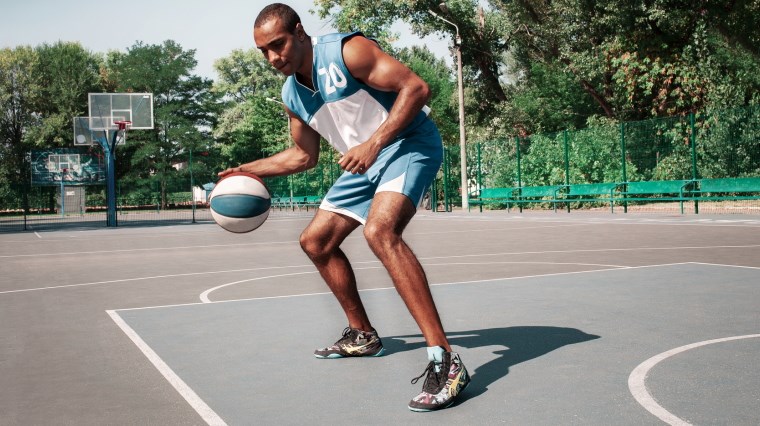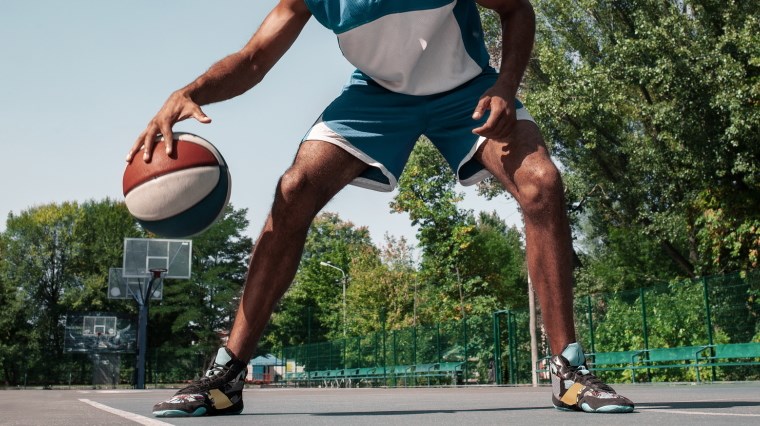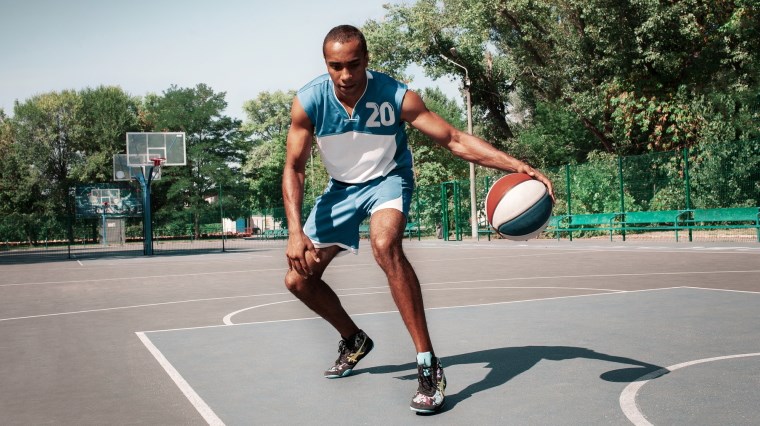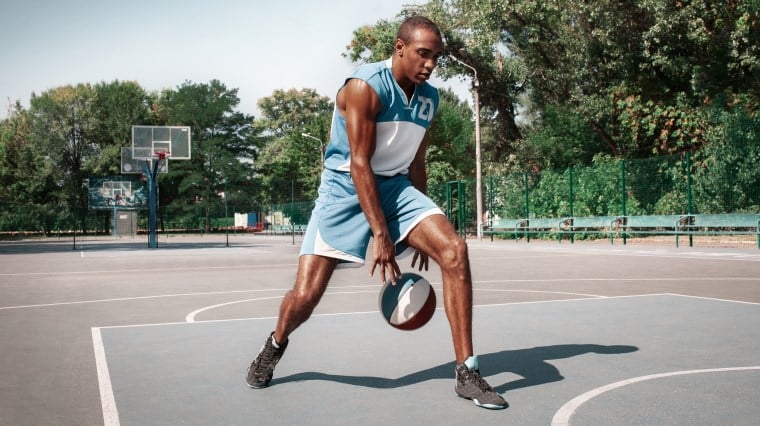Effective Basketball Drills To Improve Your Dribbling At Home

To be a skilful basketball player, not only do you need to be intuitive, have quick decision-making skills and work in harmony with your team, but you need a firm grasp of the fundamental basketball skills.
Practicing basketball dribbling drills alone benefits both you and your team when it’s time to put your dribbling skills into practice on game day. The point guard is the ball-handling wizard of the team, making dribbling particularly paramount to their skill set, however it is recommended that all players hone their dribbling skills.
Even when you don’t have access to your coach, a basketball court or your team, you can practice your ball-handling and improve your dribbling skills at home with these 7 beginner basketballs drills you can do on your own. All you need to do is choose a basketball and find a hard surface like a driveway or your local court to get started.
Focus on fingertips: Improved control

Beginners usually underestimate the necessity of fingertip control. Much of the skill required to direct a basketball is in the fingertips, not the palm. To break the habit of using a slapping motion of the palm to dribble, it’s recommended that you practice the following.
Hold a basketball in front of your chest and throw it between your two hands, with fingers spread wide. Keep your hands a short distance apart and concentrate on your fingertips to keep the basketball steady during the motion, rather than slapping it between your palms.
Once you’ve gained confidence, raise both hands and continue the action above your head and then below your knees, paying special attention to your fingertips as they guide the basketball back and forth.
Alternate your hands: Dexterity and adaptability
It’s important to practice dribbling with both your dominant and non-dominant hand to improve your dexterity on the court and increase your adaptability to counteract the strategies of your rival team, particularly when the pressure heats up.
When practicing dribbling with your non-dominant hand, keep your dominant hand behind your back to prevent it from being a distraction, or raise it as an arm bar while keeping it close to your body as if you were blocking a defender.
To reinforce the skill, use your non-dominate hand for everyday tasks (e.g. brushing your teeth, opening doors and drawers and eating). It will feel strange at first, but in the long run using your non-dominant hand will feel more natural on and off the court.
Practicing dribbling with both hands allows you to identify areas of weakness to work on, and in turn inspires confidence in your movement through improved proprioception and coordination. Having this adaptability to dribble with both right and left hands will give you an edge over the competition and allows you to play more creatively.
Skilled opposition will quickly catch on to whether you have a ‘weak’ hand and will force you into a position where you must use it. Alternatively, with both your hands having a similar or equal level of ball control, you’ll keep your defender on their toes.
Crossover dribbling: Changing direction

Your ability to confidently use both hands on the basketball court shines with techniques like the crossover dribble. Having a skilled crossover dribbling technique can keep the basketball out of your defender’s grip, allowing you to change direction at a moment’s notice and potentially in an unanticipated way.
To practice a basic crossover dribble, take an athletic basketball stance with feet slightly more than shoulder-width apart, chin up and knees slightly bent to keep your body low to the ground. Aim to release the basketball when your hand is just outside your knee and pound it aggressively into the ground in front of your body to increase its speed.
Contact the basketball with the other hand when it’s outside your opposite knee and once again pound it strongy to the ground, centred between your feet to your opposite hand and repeat. The basketball should move roughly in a 'V' shape from one hand, to the ground, to your opposite hand and stay below knee level to keep it well-guarded from your defender.
Practicing stationary crossover drills increases your fingertip control, speed and allows you to gain a feel of how strongy and aggressively to pound the basketball without losing control. On game day you'll want to move explosively, shifting your body from side to side to quickly change direction and accelerate the pace to outmanoeuvre any attempts by your defender to steal the basketball.
High dribble: Improved speed
It’s not enough to have dribbling skills in a static position – you must be able to maintain control and coordination while covering a large area of the court during high-speed play. Once you are confident dribbling while walking, gradually increase the pace by jogging, running and eventually sprinting.
To practice speed dribbling, bounce the basketball in front of you in a straight line at waist height while you run. As you quicken the pace, the basketball must be bounce further out in front of your body to maintain momentum, with your hand making contact with it no higher than your hip to maintain control at speed.
Speed is critical, but so is the ability to accelerate or decelerate with control, changing the pace as required to take advantage of any opportunities that arise for your team.
When speed dribbling, practice explosive changes of direction and concentrate on dribbling as few times as possible to receive the desired outcome. The more the basketball spends in contact with your hand, the more control you have as you race down the court.
Double dribble: Coordination & multi-tasking skills
Often chaos is what is missing from your solo dribbling drills. When training from home, mirroring game day situations can be a challenge. Double dribbling or dribbling two balls simultaneously – one in each hand – can add that ‘chaotic’ element to your training, keep you primed for the unexpected on game day and improve your multi-tasking skills.
In a basketball stance, pound two basketballs – one in each hand slightly in front of and outside your toes. Aim for the basketballs to bounce together to waist height during this dribbling drill. As your skills advance, you can design a dribbling course out of cones that includes straight lines, zig-zagging and directional changes. Walk or lightly jog the course while double dribbling, with a focus on remaining controlled and coordinated.
Figure 8 dribbling: Ball handling & agility

Familiarising yourself with the basketball and how it responds to different levels of force as you guide it around your body will benefit both you and your team at critical moments that can influence the outcome of the game.
Stand with your legs relatively wide apart with knees bent, lowering your body close to the ground. In a figure 8 pattern, dribble the basketball around and in between your legs. Vary this beginner basketball drill by doing low dribbles close to the ground with a goal to do as many dribbles as possible or higher dribbles, with a goal to do as few dribbles as possible to achieve the figure 8.
Increase speed to take the difficulty up a notch and practice doing the figure 8 from all directions (front to back and back to front), with your dominant hand and your non-dominant hand. During this basketball drill, balance and control is crucial – aim to manoeuvre the ball around your body, not the other way around.
‘Blindfold’ dribble: Improved feel and confidence
Beginner basketball players frequently keep their eyes down on the basketball when dribbling, however this should be discouraged and frequently it’s simply a matter of confidence. On game day, your attention will need to shift between both your teammates and the opposition, searching for clear opportunities to progress the ball down to the hoop rather than maintaining eye contact on the basketball itself.
Practice dribbling in a stationary position with a blindfold or eyes closed will train you to rely more on feel than sight to control the basketball confidently. Once you’re skilled in ‘blindfold’ dribbling while in a static position, you can repeat the exercise at a walking pace, having firstly made sure you’re in an environment where it is safe to do so.
When you’ve proved to yourself that you can dribble blindfolded without losing control of the basketball, you’ll be more confident dribbling with your eyes and head up. You can keep your eyes trained on a spot on the wall during dribbling drills. On game day this will allow you to mentally take in the expanse of the court, keep alert of the constant movement of team and opposition and avoid losing a critical opportunity to pass.
